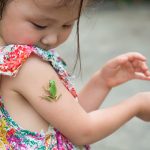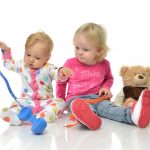 Toys open a world of imagination for your toddler. From building blocks to musical instruments, every toy has a purpose for learning and development. Not all toys are equal, though; some may even be dangerous for your toddler even though they’re marketed for her age group.
Toys open a world of imagination for your toddler. From building blocks to musical instruments, every toy has a purpose for learning and development. Not all toys are equal, though; some may even be dangerous for your toddler even though they’re marketed for her age group.
As a parent or caregiver, it’s important to know how to choose toys that are not just developmentally appropriate for your child, but also safe. Here are a few tips to help you find safe toys and also keep her safe as she enjoys them.
Highlights:
|
Choosing Safe Toys for Your Toddler
Just because a new toy on a store shelf is labeled for your toddler’s age, or comes from a trusted brand, doesn’t automatically make it safe. Checking the recommended age and package warning labels should be your first step toward ensuring a toy’s safety, but you can also check for dangers such as:
Choking hazards, such as small parts that can easily be removed from the toy or small accessories sold with the toy. Accessories should never be large enough for a toddler to swallow, and all pieces of the toy should remain securely attached.
Plug-in toys, which can be a fire hazard for young children to operate. Instead, stick with battery-operated toys with a screw-on battery cover. Or even better, go for non-electric toys altogether.
Magnets, which, if swallowed, can pose serious health dangers to your toddler. Again, make sure any magnets are secured within the toy and are inaccessible by little hands.
Sharp or pinching pieces, which you might find on plastic or wooden toys. All edges should be smooth, and the toy should have no parts that might scratch or pinch little fingers.
Toxic materials. Check the labels to make sure the toy and all its materials are labeled “non-toxic.”
For ride-on toys, thoroughly read the labels to make sure your toddler is the recommended height and weight for the toy. She should also be able to sit up on her own. Safety belts or harnesses are a welcomed added safety feature of these toys.
Keeping Your Toddler’s Toys Safe
Choosing durable toys is an integral part of finding ones that can keep up with your toddler’s everyday use, but any toy is susceptible to wearing down over time. You can take these steps to make sure they stay in the best condition possible:
Check toys periodically.
It’s a good idea to get into the habit of routinely checking your toddler’s toys. You might choose to do it once a week or once a month. Look for snags or rips on stuffed animals, battery leaks on electronic toys, or plastic parts that might be wearing down or feel sharp. Peeling paint and rust are also signs that toys are ready to retire.
Clean toys before storing them.
Not all toddlers are entirely out of the stage of putting toys in their mouths. Unfortunately, this habit can take its toll on toys – especially those with porous surfaces, like stuffed animals – because it can spread bacteria. As the toys sit, the number of bacteria could multiply to harmful levels that can make your toddler sick.
Take a few minutes to wipe down plastic and wooden toys with warm, soapy water before putting them in drawers, on shelves, or in containers. The American Academy of Pediatrics also suggests placing any toys that are dishwasher-safe in the dishwasher for better cleaning and sanitizing.
Consider washing stuffed animals once a week. You can clean many stuffed animals by placing them in a pillowcase and using your washer’s gentle cycle to wash them. Then, dry them on low heat or use the air-dry setting.
Have your toddler help you clean up toys.
Learning to clean up after herself teaches your toddler responsibility, but it also lends well to toy safety. Putting her toys in their designated containers or on shelves after she’s done using them keeps them off the floor and can prevent trips and falls. It can also protect her toys from pets who might chew them!
Your toddler uses toys every day to learn and grow. Choosing the right ones will help her stay safe while enjoying them! Sharing these tips with family members and caregivers who also purchase toys for your toddler can ensure that everyone’s on the same page.








